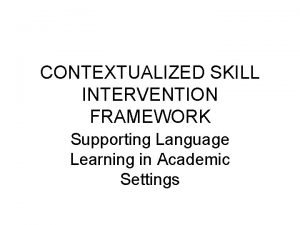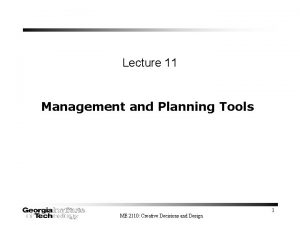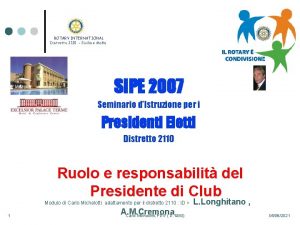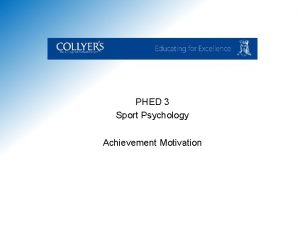Sport for Development Karley Desrosiers PHED 2110 Fall

















- Slides: 17

Sport for Development Karley Desrosiers PHED 2110 Fall 2014

“Sport is increasingly recognized as an important tool in helping the United Nations achieve its objectives, in particular the Millennium Development Goals. By including sport in development and peace programs in a more systematic way, the United nations can make full use of this cost-efficient tool to help us create a better world. ” Ban Ki-moon, United Nations Secretary. General

Introduction ● Sport, being extremely influential in society, has the power to improve common social problems regardless of severity ● Although there are faults with the ideas and methods, many of the programs in place with a “Sport for Development” approach achieve positive results ● The homeless world cup is an example of an athletic medium of combatting a common social issue ● The organization has much success in helping underprivileged people achieve higher goals

Sport Participation ● “Full participation in sporting communities is ensured only when there is equitable access and opportunity” ● Because of the influential nature of sport, in order to have full effect of the power for change, sport opportunities must be available for all individuals regardless of; race, class, gender, ethnicity, religion, culture or socioeconomic factors ● Sport as a device for building values that apply to society as well: ○ Achievement ○ Discipline ○ Teamwork ○ Health and fitness

Education and Child and Youth Development ● Promote physical activity which leads to improved academic performance ● Keep children away from drugs, violence and crime ● Learn key values and how to cope with winning and losing ● Good means of education because sport is so appealing to the younger generation ● Sports programs that require attendance and scholastic achievement ● These theories are prevalent as well in third world countries (children in Namibia)

What is Sport For Development? ● Influential institutions, organizations, agencies, etc. to promote social development using sport as the medium for change ● Using the approach to answer questions such as: ○ how can sport be used for conflict resolution? ○ How do phys ed programs in schools affect child development, both academically and health wise? ● When referring to sport in this context, sport is defined as any activity promoting physical activity mental wellness and social interaction ● https: //www. youtube. com/watch? v=p. C 0 AVo. Gxmvs

UN ● The United Nations strongly believes in the power of sport in development. ● UN Millennium Development Goals: ○ Eradicate extreme poverty, hunger, child mortality ○ Universal primary education ○ Gender equality and empowerment of women ○ Improve mental health ○ Global partnership for development ○ Environmental sustainability

Barriers to Sport Participation ● Individuals who are unable to participate in sport because of certain barriers such as: ○ Age ○ Gender ○ Socioeconomic status ○ Race ○ Disabilities/Injury ○ Homelessness

Barriers to Sport Participation: Injuries & Disabilities ● Although there are many opportunities for disabled individuals to participate in sport, there also many barriers; ○ Depending on when the injury occurred, many people don’t get an early start ○ People may be unsure of how to include those with disabilities ○ Lack of transportation, facilities, coaches, etc. ○ Discrimination ■ Disabled women are at the greatest disadvantage

Barriers to Sport Participation: Homelessness ● The definition of homelessness is ambiguous across different nations ● Homelessness on a spectrum as opposed to set criteria ○ Ex. An individual who is completely homeless compared to an individual who doesn’t have a home of their own but relies on shelters, friends or family. ● Homelessness is a situational form of social exclusion ● Social exclusion- combination of issues such including: ○ Unemployment ○ Poor skills ○ Low income ○ Inadequate housing ○ Criminal tendencies or environments ○ Poor health ○ Unstable family environment

Causes and Effects of Homelessness ● Rates of mental illnesses is greater among the homeless population, most commonly anxiety, depression and schizophrenia ● Commonly a result of a rough upbringing ● In some cases homelessness is a choice, those who feel they aren’t an active member of society choose to eliminate themselves ● Homelessness often leads to isolation ● Day-to-day survival takes priority over planning for future

Homeless World Cup https: //www. youtube. com/watch? v=LWwo 3 Wtg Ifk ● “Beating Homelessness Through Football” ● A network of 70 national partners worldwide ○ they provide athletes with services such as education and career planning, legal advice, or health services ● Goals: ○ To challenge social exclusion and promote community cohesion through sport ○ Using sports programs as a vehicle for social change and use sport to combat social issues ● Eliminating barriers between spectators and participants and stereotypes ● Many small changes collectively making a large impact ● Participants are given responsibility, connections, sense of belonging which can help get them of isolation and the endless cycle of self destruction ● Many participants significantly lower their alcohol consumption in preparation for the tournament which continues afterwards

Evolution of the HWC ● The first tournament was held in 2003 in Austria ● Began with 18 countries, currently 74 countries involved and counting ● More than 72% of past participants have now turned their lives around after the tournament ○ Getting clean, getting jobs, education, becoming semi pro athletes or coaches ● Participants become role models for homeless individuals in their country

Selection and Requirements ● To be selected you must meet the following criteria: ○ Man or woman, 16 years of age or over ○ Have not previously taken part in the tournament ○ Fit the national definition of homelessness ○ Making their main living off the street ○ Currently in drug or alcohol rehab and have been homeless within the two years prior to the tournament ○ Asylum seeker

Negative Impact of HWC ● Several players engaged in a 30 hour drinking binge at the end of the tournament ● The pressure, spectators, difference of lifestyle can be too much for some participants ○ Ex. New or recurring feelings of failure, humiliation, panic attacks, depression, reduced confidence and feelings of self worth

Criticisms of Sport for Development ● Although one of the goals of sport for development is equal opportunity for all, unfortunately that’s not always possible ● If an event isn’t properly organized, the barriers that are trying to be broken may become strengthened ● Priorities ○ How can a nation justify spending large amounts of money on sports facilities when the majority of the people are living in poverty ● Since sport for development is a fairly new phenomenon, there isn’t a lot of evidence to support theories and concepts ● If a “safe space” isn't available, sports can be exclusive and alienating

References Magee, J. , & Jeanes, R. (2013). Football’s coming home: A critical evaluation of the Homeless World Cup as an intervention to combat social exclusion. International Review For The Sociology Of Sport, 48(1), 3 -19. doi: 10. 1177/1012690211428391 Swart, K. , Bob, U. , Knott, B. , & Salie, M. (2011). A sport and sociocultural legacy beyond 2010: A case study of the Football Foundation of South Africa. Development Southern Africa, 28(3), 415 -428. doi: 10. 1080/0376835 X. 2011. 595997 Spaaij, R. , & Schulenkorf, N. (2014). Cultivating Safe Space: Lessons for Sport-for-Development Projects and Events. Journal Of Sport Management, 28(6), 633 -645. doi: 10. 1123/jsm. 2013 -0304 Tannenwald, D. (2013). The Power to Change the World? The Role of Sport in Development. Kennedy School Review, 136872. Bruening, J. E. , Peachey, J. W. , Evanovich, J. M. , Fuller, R. D. , Murty, C. C. , Percy, V. E. , &. . . Chung, M. (2015). Managing sport for social change: The effects of intentional design and structure in a sport-based service learning initiative. Sport Management Review, 18(Managing Sport for Social Change), 69 -85. doi: 10. 1016/j. smr. 2014. 07. 002 Foundation - Homeless World Cup. (n. d. ). Retrieved from http: // www. homelessworldcup. org/content/foundation Home : International Platform on Sport and Development. (n. d. ). Retrieved from http: //www. sportanddev. org/ United Nations Sport for Development and Peace - Home. (n. d. ). Retrieved from http: //www. un. org/wcm/content/site/sport/
 Phed phed rosebery
Phed phed rosebery Martine desrosiers
Martine desrosiers Karley westman
Karley westman D
D čos 051672
čos 051672 Matrix diagram
Matrix diagram Korbel portfolio
Korbel portfolio Raisecom.com
Raisecom.com Rotary distretto 2110 organigramma
Rotary distretto 2110 organigramma Me 2110
Me 2110 Millog lyly
Millog lyly Formuö
Formuö Typiska novell drag
Typiska novell drag Nationell inriktning för artificiell intelligens
Nationell inriktning för artificiell intelligens Vad står k.r.å.k.a.n för
Vad står k.r.å.k.a.n för Shingelfrisyren
Shingelfrisyren En lathund för arbete med kontinuitetshantering
En lathund för arbete med kontinuitetshantering Kassaregister ideell förening
Kassaregister ideell förening
































